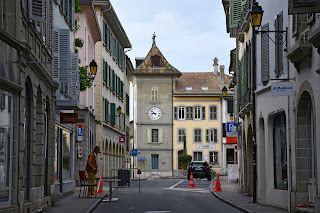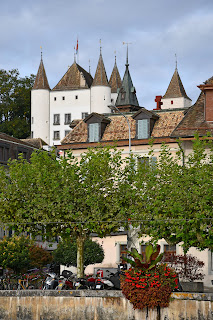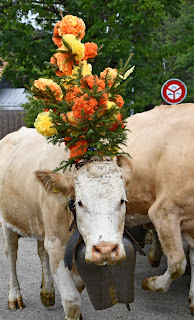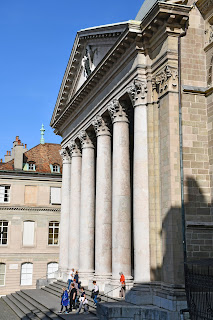When the Cows Come Home: The Désalpe in Saint-Cergue
Towards the end of September and beginning of October, many Swiss villages celebrate a tradition known as the Désalpe (or Alpabzug in German-speaking Switzerland and Almabtrieb in Germany and Austria). The tradition celebrates the return of the cows from their summer pastures in the mountains: the more touristy Swiss villages deck out their cows in towering flower crowns and put on shows to fill in the time between the descent of various herds. In Saint-Cergue, for example, the entertainment during these pauses was provided by alpenhorn players, yodelling choristers, an orchestra band, and a singular man cracking his long, supersonic cow whip. There were also two other processions: one composed of cart-dragging Saint Bernards, and another one of men carrying cowbells.
I am not sure what Désalpes
look like in other villages, but the one in Saint-Cergue was very charming. A
herd’s arrival was always heralded by a man wielding two flags: the Swiss flag
and a bi-coloured flag saying “Liberty and Homeland” in French. Following him
was either a woman holding a basket and a sign to denote which farm the cows
came from or – in the absence of such a woman – a flower-bedecked tractor.
After these came the main act: a traditionally dressed row of villagers at the
front of a jogging herd of cows. A few more trailed behind to make sure the
cows did not stray from their path, and some closed the very back of the
procession, usually bringing with them a little boy. The whole festivity was
accompanied by the thundering of huge and ornate cowbells.
Such a spectacle
awaited those who made it to the village of Saint-Cergue over an hour’s
distance from Geneva. To get there, I took the train to Nyon, but because I
arrived half an hour before the connection to Saint-Cergue, I strolled through
the old town and made it all the way to the lake before I got nervous and
hurried back again. The station was teeming with people when I returned.
Although I had bought a train ticket for that exact time, all the wagons were
already filled, and conductors started walking around to announce that extra
busses had been arranged to Saint-Cergue.
This was a blessing in
disguise. I had originally bought a ticket for one stop after Saint-Cergue,
having misunderstood the schedule I had found online. The names written on
there were not the names of places through which the cows would pass before
arriving in Saint-Cergue – as I had assumed – but the names of the places from
which the cows would come. Not getting on the train, therefore, saved me from
myself and my compulsive over-planning, which would doubtlessly have gotten me
into an unpleasant and confusing situation.
It seemed there were
silver linings for all passengers on that bus. A woman beside me had mistakenly
boarded it thinking it was bound for Geneva, and by the time she realised it
was not, the driver was unwilling to make a stop to let her off. Nevertheless,
once the first herd of cows ran down the hill past the bus, she whipped out her
phone just like everyone else and perhaps even seemed momentarily glad for the
detour. Whether she went on to tread the dung-filled streets of Saint-Cergue or
headed straight back to Nyon once she got off the train, I will likely never
know.
After watching
multiple cow herds rush by, I finally decided to search for my work friends who
had arrived after me. I had run out of data on my phone, so my plan was simply
to make several loops around the village until I found them. This method proved
rather limited. The village had set up dozens of stalls and hordes of tourists
had laid siege to the streets, making the search as difficult as finding the
proverbial needle in a haystack. In the end, I simply ended up making a phone
call.
Having spent a part of
the afternoon with my friends, I headed back to Geneva again. Despite living
there for an entire month, I had never properly explored the historic centre,
and the weather was nice enough to convince me that it would be worth it.
Winding my way to the Cathedral of Saint Peter, I stopped by the Temple de la Madeleine and took in the views from the terraces
overlooking the city and the lake. The best view of the lake, however, was from
the tower of the Cathedral itself, which is accessible for a fee. There is also
a lovely chapel inside the cathedral that was converted to secular use at the
height of Protestant fervour but was restored to its almost gaudy ornateness in
more tolerant times.
Speaking of
Protestantism, just south of the Cathedral lies the Reformation Wall, which depicts
some of the movement’s most important figures as well as their political
patrons. From thence, I continued to my last stop in the east: Immeuble Clarté, a visually unremarkable complex that I wanted to check off my list
because it forms part of Le Corbusier’s UNESCO-listed collection of works.






















































Comments
Post a Comment